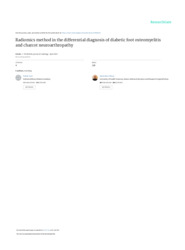Radiomics method in the differential diagnosis of diabetic foot osteomyelitis and charcot neuroarthropathy
-
Yazar
Gökalp Tulum
Onur Osman
-
Tür
Makale
- Yayın Yılı 2023
- Veritabanları Wos,Scopus,PubMed
- DOI 10.1259/bjr.20220758
-
Yayıncı
British Institute of Radiology
- Dergi The British journal of radiology 96, pp.1 - 11
- Tek Biçim Adres https://hdl.handle.net/20.500.14081/1904
-
Konu Başlıkları
Charcot
neuroarthropathy
osteomyelitis
diabetic foot
radiomics
Objectives: Our study used a radiomics method to differentiate bone marrow signal abnormality (BMSA) between Charcot neuroarthropathy (CN) and osteomyelitis (OM). Materials and Method: The records of 166 patients with diabetic foot suspected CN or OM between January 2020 and March 2022 were retrospectively examined. A total of 41 patients with BMSA on MRI were included in this study. The diagnosis of OM was confirmed histologically in 24 of 41 patients. We clinically followed 17 patients as CN with laboratory tests. We also included 29 nondiabetic patients with traumatic (TR) BMSA on MRI as the third group. Contours of all BMSA on T1 and T2-weighted images in three patient groups were segmented semi-automatically on ManSeg (v.2.7d). The T1 and T2 features of three groups in radiomics were statistically evaluated. We applied multi-class classification (MCC) and binary-class classification (BCC) methodology to compare classification results. Results: For MCC, the accuracy of Multi-Layer Perceptron (MLP) was 76.92% and 84.38% for T1 and T2, respectively. According to BCC, for CN, OM and TR BMSA, the sensitivity of MLP is 74%, 89.23%, and 76.19% for T1, and 90.57%, 85.92%, 86.81% for T2, respectively. For CN, OM, and TR BMSA, the specificity of MLP is 89.16%, 87.57%, and 90.72% for T1 and 93.55%, 89.94%, and 90.48% for T2 images, respectively. Conclusion: In the diabetic foot, the radiomics method can differentiate the BMSA of CN and OM with high accuracy. Advances in knowledge: The radiomics method can differentiate the BMSA of CN and OM with high accuracy.
-
Koleksiyonlar
Fakülteler
Mühendislik Fakültesi


 Tam Metin
Tam Metin

